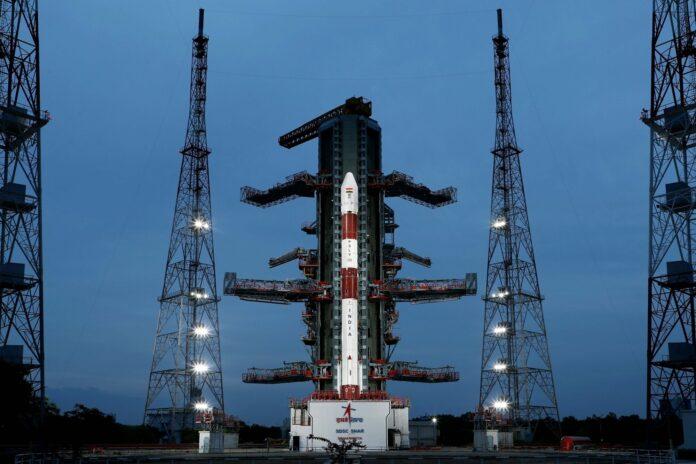(Our Special Correspondent)
Space is critical importance both in strategic and commercial terms. Satellite launch vehicles overlap considerably with missile launch technology.And, Indian Space Research Organization (ISRO), established to promote country’s overall ambitious, indeed made commendable progress, despite insignificant budget allocations with world’s largest constellation of remote-sensing satellites and the GAGAN and NAVIC satellite navigation systems. It has sent two missions to the Moon and one to Mars. Similarly, the achievements so far in R & D of missiles, the Unarmed Aircraft Systems (UAS), nuclear technology fields and semi- conductor fields, besides others, undoubtedly encouraging.. The ability to re-use rockets, obviousy calls for additional sets of capabilities.
After India signed the nuclear deal with the US in 2008, the path was cleared for India’s membership of MTCR, the Missile Technology Control Regime that regulated access to critical technologies significantly multiplied.. India can now access technology and even invite foreign investment in space ventures.
Satellites are being put to ever greater use across the world, for an ever-expanding number of purposes, including military and non-military uses. Satellites are not just about launch capability. These involve complex technologies in signaling, materials, miniaturization of already tiny electronics, power generation and management systems, sophisticated radars, telescopes, and many more things. Rocket engines need steady improvement. Most importantly, Geo location services depend on satellites. Turning off or corrupting geo location during complex military maneuvers and the ability to thwart it could mean the difference between defeat and victory in battle. Other than telecommunications, spotting methane emissions, using ground-penetrating radar to spot underground formations, crop maturity and cropped area are some of the uses. It is vital for India to develop capability across the range of technologies that go into the space economy. It is impossible for the state sector alone to produce all the innovations India’s strategic capability and economy would need from the space sector.
So far, private companies’ role in the space programme had been limited to making parts and systems for ISRO. When start-ups take up the technological and business challenges thrown up by a growing and diversifying space economy, it would create thousands of high-skill, high- value jobs, produce technologies that would have diverse applications far removed from space — ‘stay-cool’ undergarments that make use of ‘phase change’ materials developed to regulate the temperature inside space suits are just one example — in civilian and defense sectors.
The ISRO “Saga or Story” regarding the design, development and production of Space Technologies is reviewed in outline. Space research started in 1962 only. Key Milestones of ISRO: Founding Scientist – Vikram Sarabhai; 1962 – Established as the Indian National Committee for Space Research (INCOSPAR) under the Department of Atomic Energy (DAE); January 1965 – Space Science and Technology Centre (SSTC) established in Thumba, Kerala; 1969 – became ISRO within DAE; and in 1972, Space Commission and DOS established bringing ISRO under it.
Nonetheless, as of 2022, out of 77 different government space agencies in existence, the ISRO is one among the six government space agencies to have full launch capabilities (ability to launch and recover multiple satellites, develop and deploy cryogenic rocket engines and operate space probes) and extraterrestrial landing capabilities. And, only three nations have human spaceflight capability to include: USA; Russia; and China. China is the only country with extraterrestrial landing capability.
Furthermore, the programme run by ISRO from the beginning is focused on developing capabilities in three distinct fields: ‘Satellites for Communication and Remote Sensing’, ‘Space Transportation System’ and ‘Application Programmes’. Satellites are deployed in GSO
(Geosynchronous Orbit), GTO (Geosynchronous Transfer Orbit), LEO (Low Earth Orbit), and SSPO (Sun Synchronous Polar Orbit) for “Earth Observation, Communication, Experimental, Disaster Management System and other purposes”. Today, India has two operational launchers – expendable launch systems -developed and operated by the ISRO: Polar Satellite Launch Vehicle (PSLV) and Geosynchronous Satellite Launch Vehicle (GSLV). The difference between systems lies in the difference in their payload capabilities. For example: PSLV can carry satellites up to a total weight of 2000 kg into space in
sun synchronous orbit of 622 kms and reach up to an altitude of 600-900 km and. GSLV can carry weight up to 5,000 kg and reach up to 36,000 km.
As of 23 October 2022, India has launched 381 satellites for 34 different countries. Also as of 01 July, 2022 the PSLV has made 55 launches, with 52 successfully reaching their planned orbits, two outright failures and one partial failure, yielding a success rate of 94%. And, GSLV was used in 14 launches from 2001 to 2021 resulting in 8 successes, four failures, and two partial failures. GSLV (Mark III) is ISRO’s third generation rocket that has a gross lift-off weight of 640 tones. ISRO has renamed GSLV Mark III to Launch Vehicle Mark III or LVM III because of its successful mission to place the satellites in Low Earth Orbit. Low earth orbit’s satellites are usually placed less than 1,000 kms above the earth’s surface, while satellites in Geostationary Equatorial Orbit are placed 35,000 km above the surface. The GSLV LVM III rocket’s powerful cryogenic stage enables it to place heavy payloads into Low Earth Orbits of 600 km altitude. It is capable of placing the 4 tones class satellites – launch geostationary communication satellites (GSAT series) – into Geosynchronous Transfer Orbits. GSLV MkIII-M1, successfully launched Chandrayaan-2 spacecraft on 22 July, 2019 into its planned orbit with a pedigree (nearest point to Earth) of 169.7 km and an apogee (farthest point to Earth) of 45,475 km.
ISRO is developing a Next-Gen Launch Vehicle (NGLV) to replace operational systems like the PSLV. In NGLV, ISRO is looking at a cost-efficient, three-stage to orbit, reusable heavy-lift vehicle with a payload capability of ten tones to Geostationary Transfer Orbit (GTO). It will feature semi-cryogenic propulsion (refined kerosene as fuel with liquid oxygen (LOX) as oxidizer) for the booster stages. Potential uses will be in launching communication satellites, deep space missions, future human spaceflight and cargo missions.
Key PSLV series launches include: 2008 – Chandrayaan-1 launched; 2010 – Radar Imaging Satellite (Risat-1, 2 and 2 B); Cartosat-2B, 3, and 727.5 kg Cartosat-2 Series Satellite for earth observation and 19 co-passenger satellites into a 505 km polar Sun Synchronous Orbit (SSO); STUDSAT and three small foreign satellites; Resourcesat-2 and two small satellites; Indigenous Regional Navigation Satellite IRNSS-1A, 1E, 1 G, seventh satellite of the IRNSS to a Sub-Geosynchronous Transfer Orbit (Sub-GTO) and IRNSS-11 Navigation Satellite and HysIS and 30 customer satellites; Mars Orbiter Mission launched; multi-wavelength space observatory Astrosat; six satellites of Singapore; SCATSAT-1 for weather related studies and 7 co-passenger satellites into SSO; 31 Satellites in a single flight; Microsat-R and Kalamsat-V2; EMISAT and 28 customer satellites; and CMS-01 and EOS-01;2021 – EOS-04; and 2022 – 2xEOS-04 missions. GSLV series launches include: 2014 – launched Mars Orbiter mission (MOM) or Mangalyaan and also GSLV Mk-III, the first experimental flight of ISRO’s heaviest and upgraded rocket vehicle; 2015 – India’s 4th navigation satellite launched; 2016 – launched INSAT-3DR, an advanced weather satellite, weighing 2211 kg into a GTO, GSAT-18 was inducted into the INSAT/GSAT system; 2017 – launched 104 satellites using a single rocket, South Asia Satellite,
GSAT-19 Satellites, and GSAT-17 Communication Satellite; 2018 – launches GSAT-6A Satellite, GSAT-11, GSLV MkIII-D2 successfully launched GSAT-29, and GSAT – 7A; and 2019 – launched Chandrayaan-2 Moon Mission.
ISRO’s GSLV Mark 3 mission is important because of commercial agreement between NewSpace India Ltd, a space PSU, and UK-based OneWeb Ltd. The launch by ISRO and NSIL successfully deploying 36 satellites on 23 October 2022 is one of the biggest commercial orders by India’s premier space organization, and the first using the LVM3 rocket. The successful demonstration of LVM 3 rocket’s ability to carry heavier payloads will boost revenues from eachlaunch. The same rocket is currently being human-rated to carry astronauts to space under Gaganyan mission.Among others, in 2016, the first experimental mission of ISRO’s Scramjet Engine towards the realization of an Air Breathing Propulsion System was successfully conducted. Also, successfully flight tested RLV-TD. The ISRO is set for the first runway landing experiment (RLV-LEX) of its made-in-India Reusable Launch Vehicle – Technology Demonstrator (RLV-TD) from aeronautical test range in Karnataka’s Chitradurga district. According to ISROofficials, the RLV wing body will be carried using a helicopter to an altitude of three to five km and released at a distance of about four to five km ahead of the runway with a horizontal velocity. After the release, the RLV will glide, navigate towards the runway and land autonomously with a landing gear in the defense airfield near Chitradurga. ISRO has set up the Indian National Space Promotion and Authorization Centre (IN-SPACE) in
2020 to actively involve the private sector in India’s space programme. So far, private companies’ role in the space programme had been limited to manufacturing parts and systems for the ISRO. With the recent successful launch of satellites into low-earth orbits by Hyderabad- based start-up Skyroot of Vikram-S (Mission Prarambh), a rocket that has put three microsatellites into space at an an altitude of 89.5 km and a range of 121.2 km as planned,
India’s state-run space programme will evolve into a proper space economy with private sector participation. Two satellites belong to domestic customers – Chennai-based start-up SpaceKidz, Andhra Pradesh-based N-SpaceTech – and one from a foreign client- Armenian BazoomQ Space Research Lab.
Now, India has dozens of start-ups in space, building satellites, launch vehicles, propulsion systems and improved designs. Chennai IIT-based Agnikul Cosmos is waiting in the wings, with its own rockets and satellite launch business plans.
DRDO and ISRO have agreed to collaborate in India’s crewed orbital spacecraft project called Gaganyaan during which DRDOs various laboratories will tailor their defense capabilities to suit the needs of ISRO’s human space mission with critical human-centric systems and technologies like space grade food, crew healthcare, radiation measurement and protection, parachutes for the safe recovery of the crew module and fire suppression system etc. Thus far, the goals in near future include expanding satellites fleet, landing a rover on Moon, sending humans into space, development of a semi-cryogenic engine, sending more unmanned missions to the Moon, Mars, Venus and Sun and deployment of more space telescopes in orbit to observe cosmic phenomena and outer space beyond the Solar System. Long-term plans include development of reusable launchers, heavy and super heavy launch vehicles, deploying a space station, sending exploration missions to external planets like Jupiter, Uranus, Neptune and asteroids and manned missions to moons.




